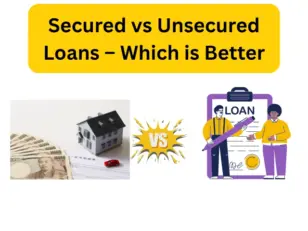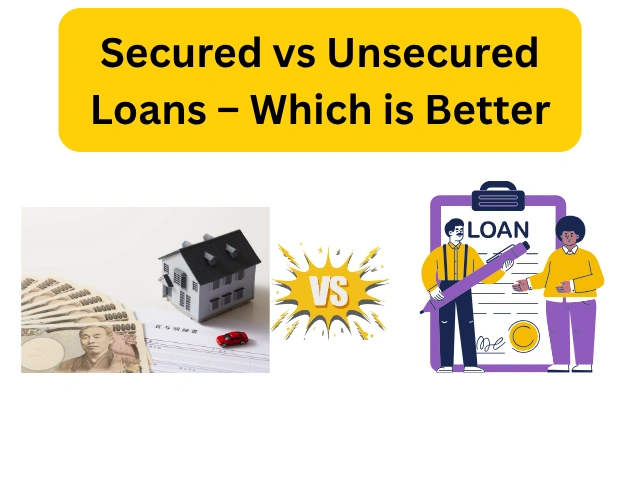Understand the difference between secured loans vs unsecured loans in the USA. Learn the pros, cons, and which option is better for your financial needs.
When it comes to borrowing money, understanding the difference between secured loans vs unsecured loans is crucial. Choosing the right type of loan can save you money, reduce risk, and help manage your finances effectively. Secured vs unsecured loans are two major categories of loans offered by banks, credit unions, and online lenders in the USA. Each has unique features, benefits, and drawbacks, making it important to know which is better for your specific financial situation. This guide will break down everything you need to know about secured loans vs unsecured loans, helping you make an informed decision.
What Are Secured Loans?
Secured loans are loans backed by collateral. This means you pledge an asset—like a car, home, or savings account—as security for the loan. If you fail to repay, the lender has the right to seize the asset.
Key Features of Secured Loans
- Lower Interest Rates: Collateral reduces risk for lenders, so interest rates are generally lower.
- Higher Loan Amounts: Lenders may offer more money since they have collateral protection.
- Flexible Terms: Longer repayment terms are often available.
- Examples:
- Mortgage loans
- Auto loans
- Secured personal loans
Secured loans are ideal for borrowers who need a large amount of money and have assets to pledge.
What Are Unsecured Loans?
Unsecured loans do not require collateral. Approval is based on your creditworthiness, income, and financial history. Since there’s no asset backing, lenders charge higher interest rates to offset risk.
Key Features of Unsecured Loans
- No Collateral Needed: Borrow without pledging any asset.
- Higher Interest Rates: Riskier for lenders, so rates are typically higher.
- Smaller Loan Amounts: Usually limited compared to secured loans.
- Examples:
- Credit cards
- Personal loans
- Student loans
Unsecured loans are suitable for borrowers who don’t have collateral or need smaller loan amounts quickly.
Key Differences Between Secured and Unsecured Loans
| Feature | Secured Loans | Unsecured Loans |
| Collateral | Required (asset-backed) | Not required |
| Interest Rate | Lower | Higher |
| Loan Amount | Higher | Lower |
| Approval Criteria | Collateral + creditworthiness | Creditworthiness only |
| Risk for Borrower | Loss of collateral if defaulted | Only credit score impact |
| Examples | Mortgage, auto, secured loans | Personal loan, credit card, student loan |
Observation: Secured loans are safer for lenders, offer lower rates, and allow larger amounts, but risk asset loss. Unsecured loans are convenient but come with higher rates and stricter credit requirements.
Advantages and Disadvantages of Secured Loans
Advantages of Secured Loans
- Lower Interest Rates – Collateral reduces lender risk, leading to lower APRs.
- Higher Borrowing Limits – Lenders are willing to provide larger loan amounts.
- Flexible Terms – Often longer repayment periods are available.
- Easier Approval for Borrowers with Lower Credit – Collateral can offset lower credit scores.
Disadvantages of Secured Loans
- Risk of Asset Loss – Defaulting may result in repossession of collateral.
- Longer Processing Time – Lenders verify the collateral, which may delay approval.
- Potential Fees – Some secured loans may have origination or collateral-related fees.
Observation: Secured loans are great for large purchases or consolidating debt but come with higher personal risk due to pledged assets.
Advantages and Disadvantages of Unsecured Loans
Advantages of Unsecured Loans
- No Collateral Needed – Borrow without risking your assets.
- Quick Approval – Often faster than secured loans, especially with online lenders.
- Flexible Use – Can be used for emergencies, travel, education, or personal expenses.
- Lower Risk to Assets – Default affects credit score but doesn’t seize property.
Disadvantages of Unsecured Loans
- Higher Interest Rates – Lenders charge more due to higher risk.
- Smaller Loan Amounts – Typically limited compared to secured loans.
- Strict Credit Requirements – Must have a good credit score to qualify for lower rates.
Observation: Unsecured loans offer convenience and safety for your assets but are more expensive and may limit borrowing.
When to Choose Secured or Unsecured Loans
Choose Secured Loans When:
- You need a large loan amount (e.g., mortgage, auto loan)
- You have an asset to pledge as collateral
- You want lower interest rates and longer repayment terms
- Your credit score is moderate, and collateral can help with approval
Choose Unsecured Loans When:
- You don’t have collateral or don’t want to risk assets
- You need a small to medium loan quickly
- You have a good credit score to secure reasonable rates
- You want fast approval for emergencies or personal expenses
Real-Life Examples of Secured vs Unsecured Loans
Example 1: John – Buying a Car (Secured Loan)
- John wanted to buy a $25,000 car.
- Took an auto loan (secured) using the car as collateral at 5% APR.
- Monthly payments: $470 for 5 years
Result: Saved interest compared to unsecured personal loan rates (~12%).
Example 2: Emily – Emergency Expenses (Unsecured Loan)
- Emily had unexpected medical bills of $5,000.
- Took an unsecured personal loan at 10% APR with a 2-year term.
- No collateral was required, approval in 24 hours
Result: Covered bills quickly without risking property.
Example 3: Mike – Home Renovation (Secured Loan)
- Mike wanted $40,000 for home improvement.
- Took a home equity loan (secured) at 6% APR, collateralized with his home.
Result: Lower interest and higher borrowing capacity than an unsecured loan.
Example 4: Sarah – Debt Consolidation (Unsecured Loan)
- Sarah consolidated $15,000 of credit card debt with an unsecured personal loan at 9% APR.
- No collateral needed, quick approval, and simplified monthly payments
Result: Reduced overall interest compared to multiple credit cards.
Tips to Get the Best Rates for Secured and Unsecured Loans
1. Improve Your Credit Score
- A higher credit score qualifies you for lower interest rates.
- Pay bills on time, reduce credit utilization, and check credit reports for errors.
2. Compare Multiple Lenders
- Banks, credit unions, and online lenders offer different rates and terms.
- Prequalify online to see potential offers without affecting your credit score.
3. Consider Collateral if Possible
- Secured loans often come with lower interest rates than unsecured loans.
- Collateral reduces lender risk and improves your chances of approval.
4. Choose the Right Loan Term
- Shorter terms usually have lower interest rates, but higher monthly payments.
- Longer terms reduce monthly payments but may increase total interest.
5. Avoid Multiple Applications at Once
- Each hard inquiry can temporarily lower your credit score.
- Apply selectively after comparing rates and terms.
6. Negotiate with Lenders
- Ask about discounts for autopay, loyalty, or bundling multiple products.
- Some lenders offer rate reductions for timely payments or existing customers.
FAQs About Secured Loans vs Unsecured Loans
1. Which is safer: secured or unsecured loans?
- Secured loans are safer for lenders due to collateral.
- Unsecured loans are safer for borrowers’ assets but may have higher rates.
2. Can I get an unsecured loan with bad credit?
- It’s possible, but interest rates will be higher.
- Secured loans may be a better option if you have collateral.
3. How much can I borrow with each type?
- Secured loans: Higher amounts, often up to hundreds of thousands (e.g., mortgage, auto).
- Unsecured loans: Typically smaller, $1,000–$50,000 depending on creditworthiness.
4. Do both affect credit score?
- Yes, timely payments improve credit, while missed payments reduce it.
- Secured loans risk collateral loss, unsecured loans only affect credit score.
5. Are interest rates fixed or variable?
- Both types can have fixed or variable rates.
- Secured loans usually offer lower fixed rates, unsecured rates can fluctuate.
6. Can I pay off a secured or unsecured loan early?
- Most lenders allow early repayment.
- Check for prepayment penalties before applying.
Summary and Conclusion
Choosing between secured loans vs unsecured loans depends on your financial situation, risk tolerance, and borrowing needs.
Key Takeaways:
- Secured Loans
- Collateral-backed, lower interest rates, higher borrowing limits
- Risk: Loss of pledged assets if you default
- Ideal for mortgages, auto loans, and large personal loans
- Unsecured Loans
- No collateral, faster approval, safer for assets
- Higher interest rates, smaller loan amounts
- Ideal for personal expenses, emergencies, and debt consolidation
- Decision Factors
- Assess your credit score, borrowing amount, risk tolerance, and repayment ability
- Compare lenders, loan terms, and rates carefully
- Use loans responsibly to maintain good financial health
Final Advice:
- If you have assets and need a large loan, secured loans can save money on interest.
- If you need a smaller loan quickly without risking assets, unsecured loans are convenient.
- Always compare interest rates, terms, and fees before deciding.
By understanding the pros and cons, you can confidently choose the loan that fits your needs while minimizing costs and risks.

